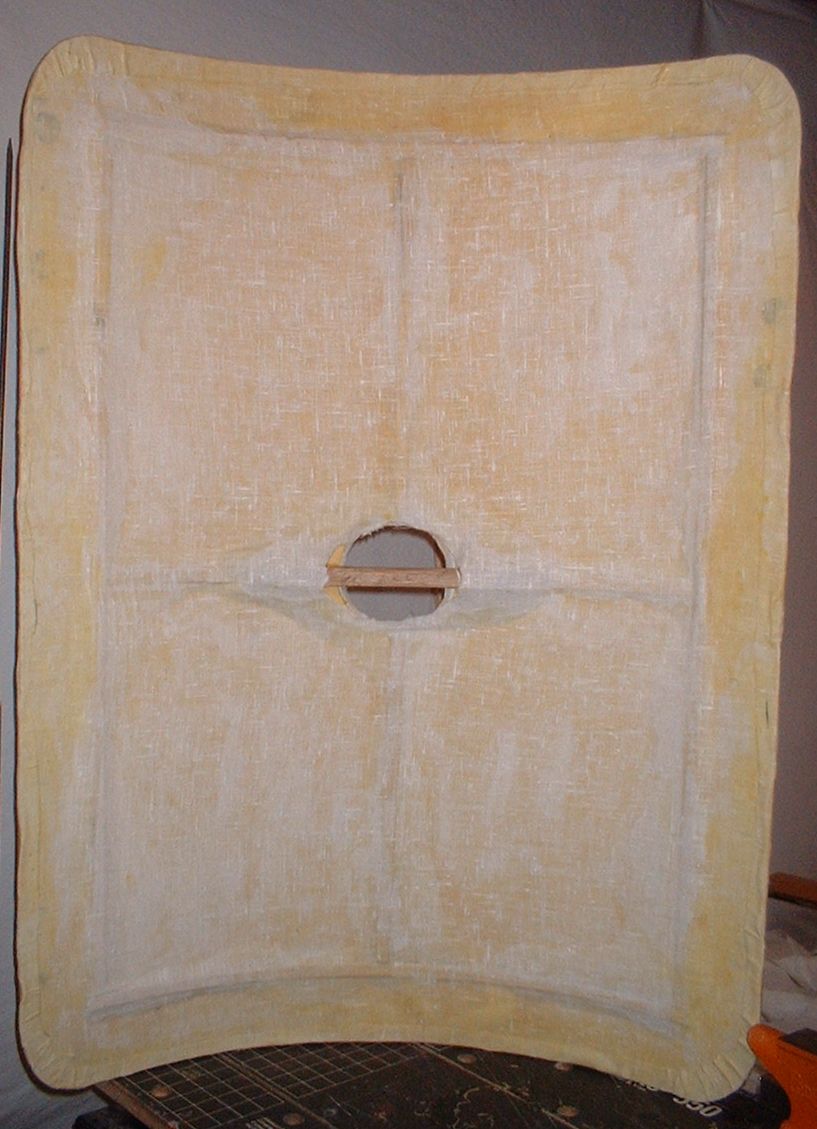 |
 |
| Equipment Soldiers carried a variety of equipment that was both offensive as well as defensive in nature. |
| Equipment The minimum requirements for any type of display or public event (excluding field demonstrations) is as follows: sandals (Caligae), belt (Balteus), tunic (white with appropriate clavii, or a red battle tunic if a white one has not been acquired yet), and if possible, a sword (Gladius). The sword must be complete with scabbard and baldric. The minimum requirements for any type of tactical demonstration or drill includes: the aforementioned kit plus a helmet (Cassis), armour (Lorica), and shield (Scutum). For non-military roles: the appropriate tunic and sandals are all that is required. In order to complete the basic 2nd Century Heavy Infantry battle kit members must acquire/fabricate the following additional items: scarf (Focale), cloak (Sagum, a heavy cold weather cloak or Paenula), javelin (Pilum), dagger (Pugio), arm guard (Manica),and shin guards (Greaves). This equipment will be necessary for weekend/overnight events. Cold weather demonstrations may require additional items. Optional Legionary Equipment Bracae: Leather trousers (for standard bearers only) Dolabra: A combination axe/pick employed for digging trenches, chopping wood, etc. Canteen Latrine Sponge: The precursor of toilet paper. Pilupe Murale (also known as a Pila Murialia): Palisade stake employed to secure the perimeter of marching camps (typically two per soldier). A Pole: for carrying equipment while on the march. Rope or Leather: For handling turfs used to build a vallum. Saw Signaculum: An inscribed lead tablet kept in a leather pouch that soldiers wore around their necks (akin to modern day dog tags). Turf Cutter/Sickle: To cut turfs for vallum construction. Wicker Basket: Used in fosse excavation for shifting earth. |
| Equipment |
| Legion Equipment |
| To contact us please click on the following: Cornicularius Legionis |
| Legio XXX Field and Parade Equipment The following is a list of the mandatory equipment for a legionary soldier in full battle dress: |
| Caligae (plus socks, laces and Insoles) |
| Tunic (red/white) |
| Focale (scarf) |
| Subarmalis (a garment worn under armour to guard against chaffing) |
| Balteus (belt) plus pugio and lorica ties |
| Pugio (dagger) and scabbard |
| Gladius (sword) and baldric |
| Greaves (shin guards) |
| Manica (segmented arm guard) |
| Scutum (shield) |
| Pilum (spear) |
| Cloak & Fibula(e) (pin) |
| Lorica (chain mail) hamata or (hoop) segmentata plus applicable ties) |
| Legionary Scutum Construction By: Lee Holeva [email protected] During the late 1st and early 2nd centuries roman scuta took on the classic rectangular shape. Archeology Much of what we know about early principate scuta construction derives from the Dura Europos scutum. Although this shield dates to the mid third century, it is not unreasonable to assume that the methods of construction mirror those of earlier periods. The dimensions: Height: 1.06 meters (42 inches) Width around the curve: 0.86 meters (34 inches) Thickness: 5-6 mm (about 1/4 inch) Chord: 0.66 meters (26 inches) The chord dimension is somewhat suspect, particularly when one considers the state of the shield remains when discovered. Converting the chord and arc length to a radius of curvature gives approximately 18 inches. Connolly describes the shield's construction as three layers of birch strips of alternating horizontal and vertical orientation. For the back bracing we have to refer to the Dura field reports. Thin wood strips formed a rectangular frame that is further bisected at the horizontal and vertical midpoints by another pair of thin wooden strips. The construction of the umbo hole and the handle differ from that of flat shields from the same period. On the flat shield the umbo hole is typically cut with a central strip of wood left remaining. The Dura shield has a complete circular opening. To quote the book by Simon James, "The central grip simply consisted of the thickening of the central portion of one of reinforcing strips at the point where it crossed the central aperture". The shield covering according to Connolly is linen over leather with a stitched-on rawhide rim. James argues that this is a misreading of the field notes and the reality is leather over linen with a rawhide rim. Another fragment of a rectangular shield from Dura Europos suggests that the fabric on the back may have been applied under the back bracing as opposed to over it. There has been considerable debate surrounding the colour of roman shields. The Dura scutum is red with decoration applied in both yellow and white. Patterns appropriate to earlier periods come largely from sculptural evidence, such as Trajan's column.] The Dura shield's boss did not survive, and only one rivet remains. Two square (domed) copper alloy bosses, one complete from the river Tyne, and a second fragmentary example from Vindonissa have ben recovered. The rim can also be made from copper alloy. Examples found at Vindonissa clearly show thin strips of metal meant to bend around the shield edge. Small semi-circular tabs were used to secure it to the shield, presumably with nails. Reinforcement strips/braces on the back of the shield need not be limited to wood; copper alloy versions have been found as well. Reproduction For a reproduction I used a curve radius of 18 inches and glued together two layers of 1/8 inch birch plywood as a substitute for the layers of birch strips. Modern linen was applied. The back bracing mirrors that of the Dura shield. Though influenced by the description of the Dura shield, my handle borrows from personal experience. The scutum is held using an over hand grip with the left hand. To make it more comfortable padding placed above the back of the hand makes all the world of difference. To accommodate the padding I offset the handle horizontally by 1/4 inch behind the umbo hole. The handle itself is made from a 1 inch by 3/4 inch piece of white oak glued and nailed to the central back bracing. Mark Morrow constructed 14 gauge bosses measuring 12 inches square for me. References Simon James, Excavations at Dura-Europos The Arms and Armour; Peter Connolly, Greece and Rome at War; M.C. Bishop, J.C.N. Coulston, Roman Military Equipment, Michel Feugere, Weapons of the Romans; Christoph Unz, Eckhard Deschler-Erb, Katalog der Militaria aus Vindonissa, Other References Goldsworthy, Adrian, Gilliver, Kate & Whitby, Steven, Rome at War (see page 114 for an excellent photograph of the Kasr el-Harit shield); Osprey Publishing, Oxford; 2005. Goldsworthy, Adrian, The Complete Roman Army (see page 31 for an artist's rendering of shield construction); Thames & Hudson, London; 2003. |
 |
| Cassis (Helmet) |
